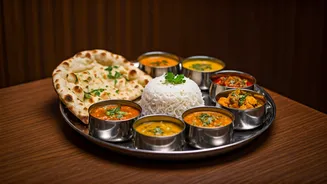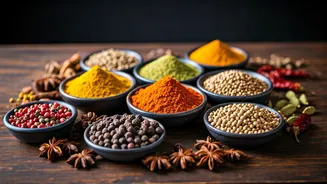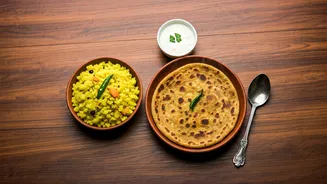Gujarat's Culinary Heritage
Gujarati food is deeply rooted in the state's history and culture, reflecting its trade relations and agricultural landscape. The cuisine is predominantly
vegetarian due to religious influences, emphasizing fresh, seasonal produce. Key ingredients include a variety of lentils (dals), vegetables, grains like rice and bajra, and an array of spices. The use of jaggery and yogurt adds a distinctive sweetness and tanginess. The preparation methods are often influenced by the region, with specific areas showcasing their unique approach to flavor and taste.
Regional Flavors Explored
Gujarati cuisine exhibits significant regional variations. Kathiawadi cuisine, originating from the Kathiawar region, is typically spicier and includes dishes like 'bharela bhinda' (stuffed okra) and 'lasaniya batata' (garlic potatoes). The cuisine of Surat is famous for its sweet and savory snacks and street food like locho and undhiyu, a mixed vegetable dish cooked in an earthen pot. Coastal regions feature seafood, prepared with local spices. Each area's cuisine reflects its unique access to ingredients, historical influences, and culinary traditions, creating a dynamic and diverse range of flavors.
Essential Gujarati Dishes
Several dishes are staples across Gujarat, showcasing the core flavors of the cuisine. 'Dhokla', a steamed savory cake made from fermented batter, is a popular breakfast option. 'Thepla,' a spiced flatbread, is often enjoyed with yogurt or pickles. 'Undhiyu', a mixed vegetable dish cooked in an inverted earthen pot, is a winter specialty, combining vegetables with spices. 'Dal Dhokli', a combination of lentil soup and wheat dumplings, provides a comforting and fulfilling meal. These dishes exemplify the balance of sweet, sour, spicy, and savory that characterizes Gujarati food.
Cooking Techniques And Traditions
Gujarati cooking employs several techniques to enhance flavors. Frying, steaming, and grilling are commonly used. The use of 'tadka' (tempering) is crucial, where spices are bloomed in hot oil to release their aroma. Slow cooking in earthen pots adds unique earthy flavors. Traditionally, food is served on a 'thali', a platter containing various dishes in small bowls. This practice allows for a balanced meal, with portions of vegetables, dals, rice, rotis, and sweets. Family gatherings often involve preparing large meals and sharing food.
The Importance of Spices
Spices are the heart of Gujarati cooking, imparting complex flavors. Cumin, coriander, turmeric, and chili powder form the base of many spice blends. Asafoetida is frequently used to add a savory depth. Mustard seeds are used in tempering to impart a distinct flavor. Each spice contributes to the overall taste profile, creating dishes that are both flavorful and aromatic. The skillful combination of spices distinguishes the cuisine.
Sweet and Savory Balance
Gujarati cuisine is known for its balance of sweet, sour, and spicy flavors. Jaggery, sugar, and dates are often used to add sweetness to dishes. Tamarind provides a sour note, while chilies and other spices offer the spice component. Yogurt is used to provide tanginess and acts as a cooling element. This balance creates dishes that are satisfying to the palate and enhances the dining experience, creating a harmonious and enjoyable culinary journey.
Gujarati Snacks And Sweets
A variety of snacks and sweets add to the Gujarati culinary experience. 'Fafda' and 'jalebi' are popular breakfast or snack combinations. 'Khandvi', a savory snack made from gram flour, is light and flavorful. 'Mohanthal', a sweet made from gram flour and ghee, is a traditional dessert. 'Shrikhand,' a sweetened yogurt dessert, is a festive favorite. These snacks and sweets provide a diverse range of textures and flavors, making the cuisine very enjoyable.











